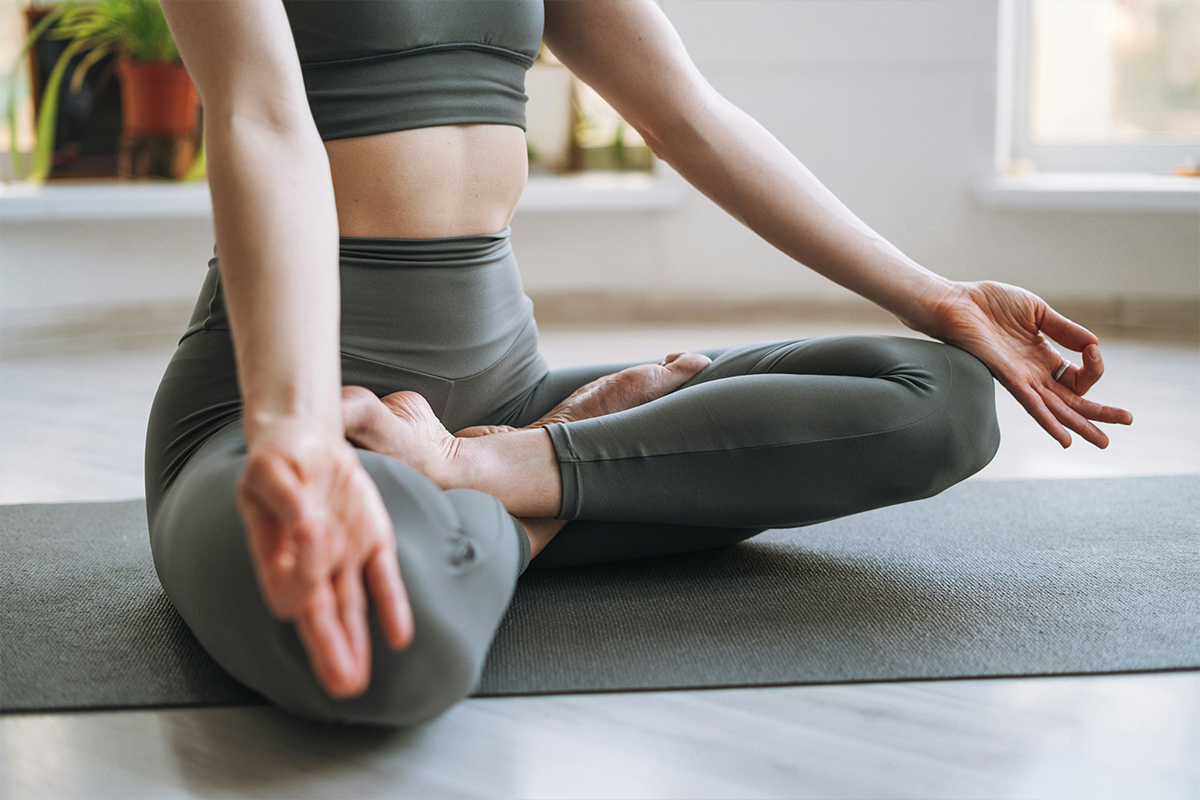Ever wondered about those mysterious pelvic floor breathing exercises everyone's talking about? These powerful yet subtle techniques can work wonders for your overall wellbeing. By syncing your breath with targeted muscle movements, you're tapping into an often-overlooked aspect of health. But don't worry if it sounds complicated - it's simpler than you might think. Whether you're looking to boost your pelvic health, manage certain conditions, or simply explore new ways to care for your body, pelvic floor breathing exercises could be just what you need. Ready to discover how a few mindful breaths can make a big difference? Let's explore the ins and outs of this game-changing practice together.
What is the connection between breathing and the pelvic floor?
The pelvic floor and breathing are intimately connected through their shared role in core stability and pressure management. When you breathe, your diaphragm and pelvic floor muscles work in tandem (1), contracting and relaxing in a coordinated dance. During inhalation, the diaphragm descends while the pelvic floor relaxes slightly. On exhalation, both ascend together.
This synergy is crucial for maintaining proper intra-abdominal pressure and supporting your pelvic organs. Pelvic floor breathing exercises capitalize on this connection, using mindful breath work to enhance pelvic floor function. By focusing on diaphragmatic or "belly" breathing, you can learn to engage and relax your pelvic muscles more effectively.
Proper breathing technique is especially important when performing Kegel exercises. Counting out loud while doing pelvic floor contractions can help maintain normal breath patterns and prevent holding your breath, which can strain these delicate muscles.
💡 With practice, coordinated breathing and pelvic floor engagement can become second nature, supporting better bladder control, sexual function, and core stability.
Who can benefit from pelvic floor breathing exercises?
Individuals with pelvic floor dysfunction
Pelvic floor breathing exercises can be particularly beneficial for those with tight or overactive pelvic floor muscles. These exercises help relax and coordinate the pelvic floor, alleviating symptoms like pelvic pain and difficulty with urination or bowel movements.
On the flip side, people with weak pelvic floor muscles can also gain strength through targeted breathing techniques. Hypertonic pelvic floor exercises such as Diaphragmatic breathing (or belly breath) is especially important for those with overly tight muscles.
Expectant and new parents
Pregnant individuals and those in the postpartum period often experience significant changes in their pelvic floor. Incorporating this kind of pelvic floor exercises during pregnancy can help prepare for childbirth and support faster recovery afterwards.
💡 These exercises are safe and beneficial even while breastfeeding, as long as they're not overdone.
Those with chronic conditions
People dealing with chronic pelvic pain conditions may find relief through pelvic floor breathing exercises. These techniques can help manage symptoms and improve overall pelvic health when practiced consistently. However, it's crucial to consult a healthcare provider before starting any new exercise regimen, especially for those with existing medical conditions.
What are the benefits of pelvic floor breathing exercises?
Pelvic floor breathing exercises offer numerous advantages for overall wellbeing. By coordinating breath with pelvic floor muscle contractions, these exercises can significantly improve both pelvic and respiratory health.
Enhanced pelvic floor function
Practicing pelvic floor breathing exercises helps strengthen and tone the muscles supporting the pelvic organs. This can lead to improved bladder control, reduced risk of pelvic organ prolapse, and enhanced sexual function. Regular practice may also alleviate symptoms of urinary incontinence, a common concern affecting up to 42% of pregnant individuals.
Improved respiratory capacity
Interestingly, pelvic floor exercises can boost lung function too. 4-week Kegel exercise program, participants showed increased forced vital capacity, peak expiratory flow, and maximal voluntary ventilation. (2) This suggests that strengthening the pelvic floor can enhance breathing mechanics and lung capacity.
Stress reduction and relaxation
Pelvic floor breathing exercises can also promote relaxation and reduce stress. Pelvic floor resonance breathing may induce larger increases in cardiac vagal activity compared to standard breathing techniques, potentially leading to stronger therapeutic benefits for mental and physical health.
Breathing techniques for the pelvic floor
Diaphragmatic breathing for relaxation
Diaphragmatic breathing, also known as belly breathing, is a fundamental pelvic floor breathing exercise. This technique helps relax the pelvic floor muscles while improving overall core stability.
To practice:
- Lie on your back with knees bent
- Place one hand on your chest and the other on your belly
- Inhale deeply through your nose, allowing your belly to rise while keeping your chest still
- Exhale slowly through your mouth, feeling your belly lower
💡 This breathing pattern can help protect the pelvic floor against high intra-abdominal pressure during physical activities.
Guided visualization for muscle awareness
Incorporating guided visualization into your pelvic floor breathing exercises can enhance muscle awareness and control. Imagine your pelvic floor as an elevator. As you inhale, visualize the elevator descending, allowing your pelvic floor to relax and stretch.
When exhaling, picture the elevator rising, gently lifting and engaging your pelvic floor muscles.
💡 This technique helps coordinate breathing with pelvic floor movements, improving mind-body connection and ensuring proper exercise form.
Reclined breathing for optimal relaxation
Practicing pelvic floor breathing exercises in a reclined position can promote deeper relaxation and better muscle engagement.
To practice:
- Lie comfortably on your back with your knees bent and feet flat on the floor.
- Place your hands on your lower abdomen.
- As you inhale, feel your belly expand and your pelvic floor relax.
- On the exhale, gently contract your pelvic floor muscles while your abdomen lowers.
💡 Consistent practice of these exercises can significantly improve pulmonary function and overall pelvic health.
Pelvic floor release exercises
In addition to strengthening, pelvic floor release exercises are also essential. These exercises focus on relaxing tight pelvic floor muscles, which can be just as important as strengthening them. They often involve deep breathing combined with gentle stretching and visualization.
How to incorporate breathing exercises for the pelvic floor into daily life?
Integrate with daily routines
Incorporating pelvic floor breathing exercises into your daily life doesn't have to be complicated. One effective strategy is to link these exercises to existing habits. For example, you could practice them while brushing your teeth or during your morning coffee ritual. This association helps make the exercises a consistent part of your routine.
Practice mindful moments
Take advantage of idle moments throughout your day to focus on your pelvic floor. While waiting in line or sitting in traffic, engage in quick breathing exercises. Breathe deeply and relax your body while gently contracting and releasing your pelvic floor muscles. These brief sessions can add up to significant benefits over time.
Combine with other activities
Multitask by incorporating pelvic floor breathing exercises into other activities. Try performing them during your regular workout routine or while watching TV. You can do these exercises in any position - lying down, sitting, or standing - making them versatile and easy to fit into various scenarios throughout your day.
Are there any risks associated with pelvic floor breathing exercises?
While pelvic floor breathing exercises can be beneficial, it's important to be aware of potential risks. These exercises may not be suitable for everyone, particularly those experiencing pelvic pain, urgency, or frequent urination without leakage. In such cases, attempting pelvic floor breathing exercises could potentially exacerbate symptoms.
Proper technique is crucial
Improper execution of pelvic floor breathing exercises may lead to muscle soreness or worsen existing pelvic floor issues. It's essential to focus solely on the pelvic floor muscles without engaging surrounding muscle groups. Coordinating breathing with pelvic floor muscle contraction is key to avoiding potential negative impacts.
Individual considerations
The effects of pelvic floor breathing exercises can vary greatly between individuals. The threshold (3) for optimal or negative effects likely differs from person to person. Therefore, it's crucial to consult a healthcare provider or pelvic floor physical therapist before starting any new exercise regimen, especially if you have pre-existing pelvic floor disorders or concerns.
Can you perform pelvic floor breathing exercises during pregnancy?
Pelvic floor breathing exercises are not only safe but highly beneficial during pregnancy. These exercises help strengthen the muscles supporting your growing baby and prepare your body for childbirth. Practicing pelvic floor exercises like Kegels can make pregnancy more comfortable and can be added to your postpartum pelvic floor exercises.
Techniques for pregnant individuals
To perform pelvic floor breathing exercises, find a comfortable position and focus on your breath. As you inhale deeply, allow your pelvic floor to relax and expand. On the exhale, gently contract these muscles as if stopping the flow of urine. Aiming for 3 sets of 8 squeezes daily, holding each contraction for up to 10 seconds.
Pelvic floor breathing exercises offer numerous benefits, from improved bladder control and posture to enhanced sexual function and reduced pelvic pain. By consistently engaging these muscles, individuals can actively promote their overall wellbeing and quality of life.
Sources:





